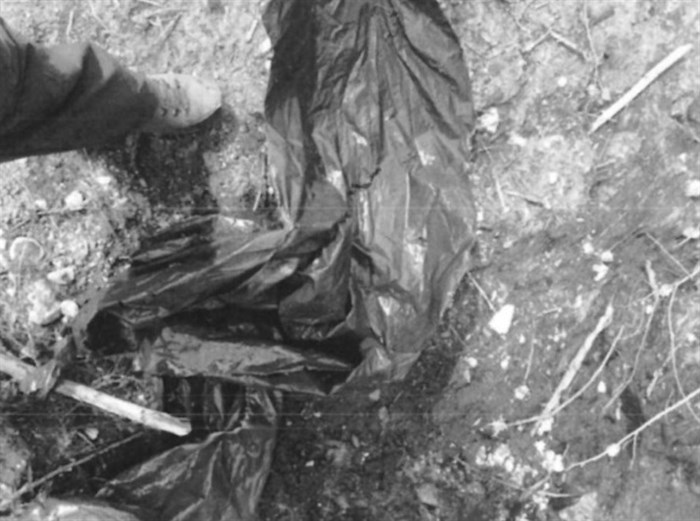
A piece of heavy-duty plastic sheeting found near the debris flow.
Image Credit: Ministry of Forests, Lands and Natural Resources
January 13, 2016 - 8:30 AM
VERNON - Plastic and wood debris found near a culvert after a devastating landslide in the North Okanagan in 2014 leads investigators to believe the flood was human caused, according to information obtained by iNFOnews.ca.
Investigators with the Ministry of Forests announced in November 2015 they believed someone intentionally blocked a culvert, causing Dale Lake to spill its banks and send a torrent of water and debris down Cooke Creek in 2014. The landslide took out part of Mabel Lake Road and damaged the Kingfisher Interpretive Centre.
Some questioned the theory that human tampering was to blame, and the province didn’t provide a wealth of details — only that other causes like beavers and ice were ruled out, and that there was a history of tampering there. Investigators also refused to say what materials they found on the day of the breach to protect the ongoing investigation.
An investigations report obtained by a freedom of information request filed by iNFOnews.ca fills in at least some of the gaps.
According to the report, several large pieces of 1-2 mm thick plastic sheets were found near the breach site and along Dale Creek. While they wouldn’t be strong enough to hold back water flowing through the culvert, ‘folding the plastic over or using multiple layers may have been sufficient to prevent flow through the culvert’ the geomorphologist said.
The report also noted that in 2012, the beaver stop attachment on one of the culverts was jammed open with a block of firewood.
“This does not occur without human intervention as the attachment is heavy and does not float, thus someone must have pulled the attachment up to insert the wood,” states the report.
Investigators also reviewed aerial photographs of the lake, and determined that it stayed roughly the same size between 1959-2007, but then appeared to double.
Investigators couldn’t figure out for sure what caused the blockage, but found it likely that plastic sheeting, plywood or other objects were used intentionally to clog the culvert.
“Why the culverts were blocked is also uncertain, but it may be that it was to increase the water depth to promote ice fishing on the lake. Greater water depth would ensure the lake did not freeze to the base and fishing conditions would be better. Who would have blocked the culvert inlets remains unknown, but I doubt they were aware of the potential consequences that their actions might trigger.”
Investigators collected information from numerous interviews with people but that information was redacted from our request "to maintain the integrity of ongoing investigation."
To contact a reporter for this story, email Charlotte Helston at chelston@infonews.ca or call 250-309-5230. To contact the editor, email mjones@infonews.ca or call 250-718-2724.
News from © iNFOnews, 2016